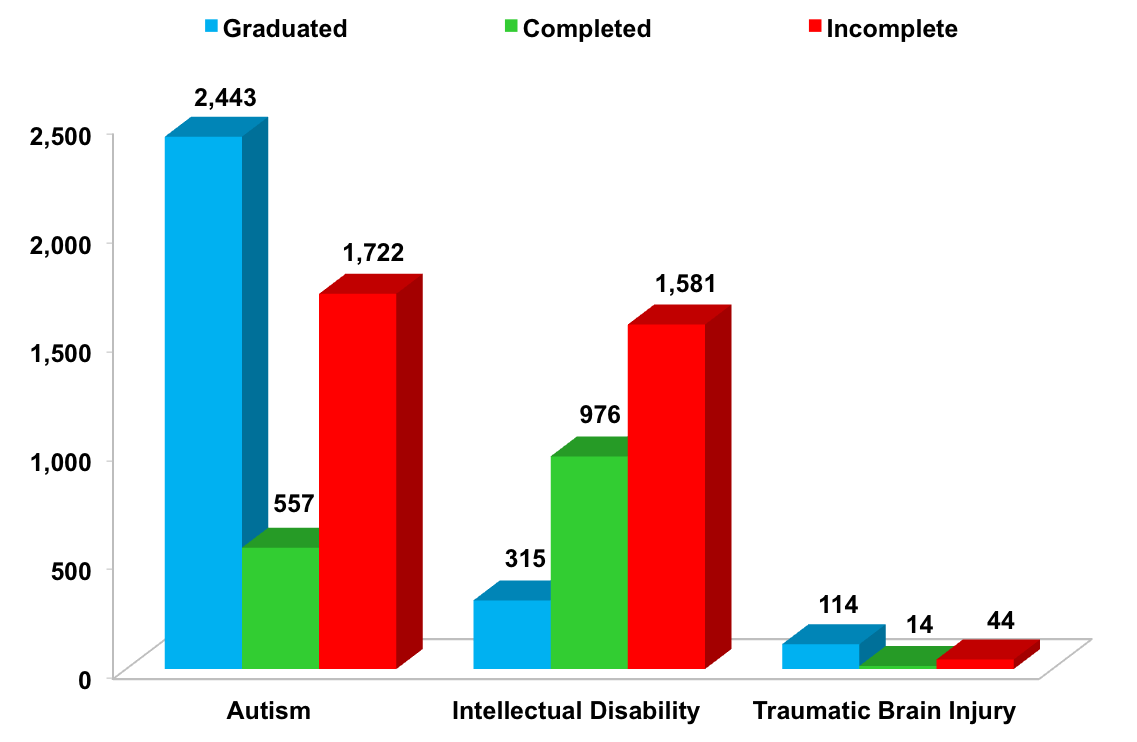Education Data
Scroll down to view prior Fiscal Years
2017-2018
| 2017-2018 Academic Year | Autism | Intellectual Disability | Traumatic Brain Injury | Totals |
|---|---|---|---|---|
| Grad. high school with regular diploma | 2,421 | 307 | 112 | 2,840 |
| Received high school completion (GED) | 10 | 1 | 0 | 11 |
| Grad. High school with diploma using exemption | 6 | 1 | 2 | 9 |
| Grad. High school with a diploma using waiver | 6 | 6 | 0 | 12 |
| Graduated Subtotal | 2,443 | 315 | 114 | 2,872 |
| Grad. high school with certificate of completion | 557 | 976 | 14 | 1,547 |
| Completed Subtotal | 557 | 976 | 14 | 1,547 |
| Reached maximum age (22) | 571 | 1,027 | 21 | 1,619 |
| Dropped out | 625 | 345 | 15 | 985 |
| Parent/self withdrawal if over 18 | 526 | 209 | 8 | 743 |
| Incomplete Subtotal | 1,722 | 1,581 | 44 | 3,347 |
| Totals | 4,722 | 2,872 | 172 | 7,766 |
DATA SOURCE: The Data is from California Department of Education as of June 2019.
2016-2017
For June 2017, the California Department of Education reports that 7,624 students with significant disabilities (autism, intellectual disabilities and traumatic brain injury) left K-12 education. Of those, 35.3% graduated, 22.8% received a certificate of completion, and 41.8% either dropped out or aged out. The table below shows more details, including the different ways a student can graduate high school with a diploma or equivalent and the ways students leave school without completion.
What this page shows us: Most students with significant disabilities continue to struggle to complete high school. Of those students who graduated, most had autism, and very few had an intellectual disability.
| 2016-2017 Academic Year | Autism | Intellectual Disability | Traumatic Brain Injury | Totals |
|---|---|---|---|---|
| Grad. high school with regular diploma | 2,280 | 265 | 115 | 2,660 |
| Received high school completion (GED) | 5 | 0 | 0 | 5 |
| Grad. High school with diploma using exemption | 3 | 2 | 0 | 5 |
| Grad. High school with a diploma using waiver | 16 | 9 | 0 | 25 |
| Graduated Subtotal | 2,304 | 276 | 115 | 2,695 |
| Grad. high school with certificate of completion | 633 | 1,090 | 18 | 1,741 |
| Completed Subtotal | 633 | 1,090 | 18 | 1,741 |
| Reached maximum age (22) | 586 | 1,077 | 23 | 1,686 |
| Dropped out | 464 | 271 | 12 | 747 |
| Parent/self withdrawal if over 18 | 542 | 199 | 14 | 755 |
| Incomplete Subtotal | 1,592 | 1,547 | 49 | 3,188 |
| Totals | 4,529 | 2,913 | 182 | 7,624 |
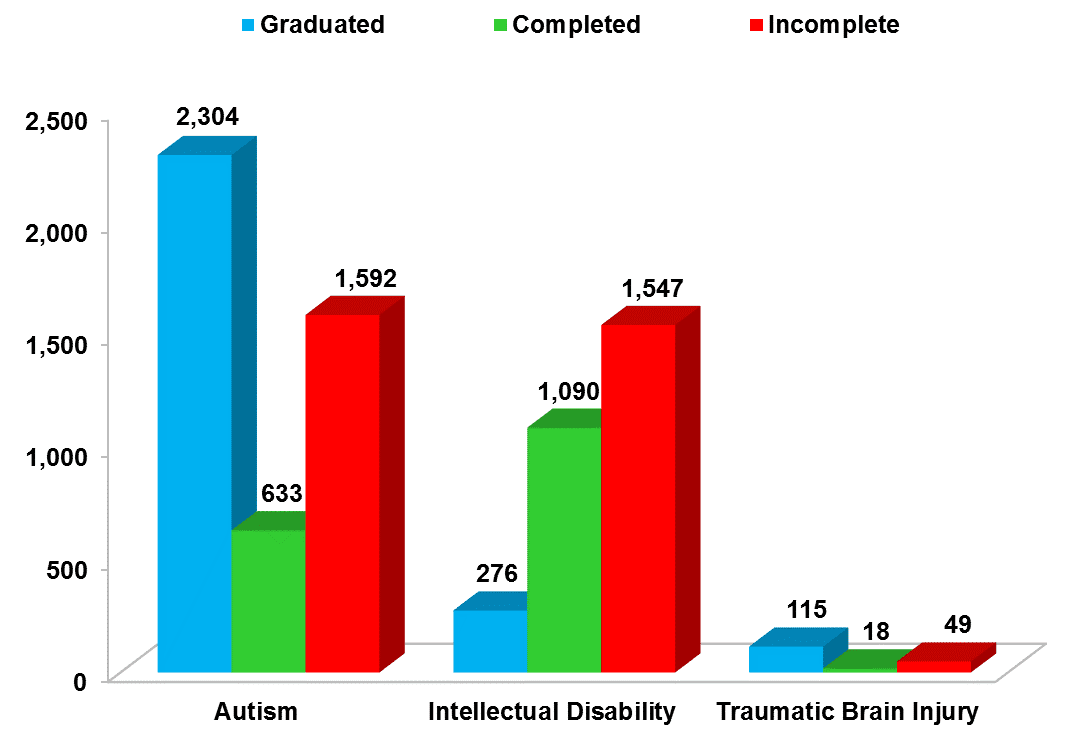
DATA SOURCE: The Data is from California Department of Education as of June 2018
2015-2016
For June 30, 2016, the California Department of Education reports that 7,071 students with significant disabilities (autism, intellectual disabilities and traumatic brain injury) left K-12 education. Of those, 35.9% graduated, 19.8% received a certificate of completion, and 44.3% either dropped out or aged out. The table below shows more details, including the different ways a student can graduate high school with a diploma or equivalent and the ways students leave school without completion.
What this page shows us: Most students with significant disabilities are struggling to complete high school. Of those students who graduated, most had autism, and very few had an intellectual disability. Most of those with certificate of completion had an intellectual disability.
Less than half of students with an intellectual disability either dropped out or aged out. Finishing high school is a requirement for many entry level jobs.
| 2015- 2016 Academic Year | Autism | Intellectual Disability | Traumatic Brain Injury | Totals |
|---|---|---|---|---|
| Grad. high school with regular diploma | 2,051 | 312 | 128 | 2,491 |
| Received high school completion (GED) | 6 | 1 | 0 | 7 |
| Grad. High school with diploma using exemption | 7 | 6 | 1 | 14 |
| Grad. High school with a diploma using waiver | 11 | 14 | 2 | 27 |
| Graduated Subtotal | 2,075 | 333 | 131 | 2,539 |
| Grad. high school with certificate of completion | 492 | 890 | 21 | 1,403 |
| Completed Subtotal | 492 | 890 | 21 | 1,403 |
| Reached maximum age (22) | 537 | 1,084 | 16 | 1,637 |
| Dropped out | 446 | 297 | 14 | 757 |
| Parent/self withdrawal if over 18 | 481 | 243 | 11 | 735 |
| Incomplete Subtotal | 1,464 | 1,624 | 41 | 3,129 |
| Totals | 4,031 | 2,847 | 193 | 7,071 |
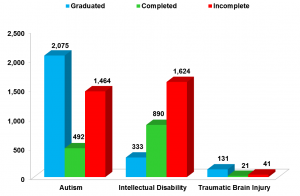
DATA SOURCE: The Data is from California Department of Education as of June 26, 2017
2014-2015
For June 30, 2015, the California Department of Education reports that 7,138 students with significant disabilities (autism, intellectual disabilities and traumatic brain injury) left K-12 education. Of those, 35% graduated, 22% received a certificate of completion, and 43% either dropped out or aged out. The table below shows more details, including the different ways a student can graduate high school with a diploma or equivalent and the ways students leave school without completion.
What this page shows us: Most students with significant disabilities are struggling to complete high school. Of those students who graduated, most had autism, and very few had an intellectual disability. Most of those with certificate of completion had an intellectual disability.
Less than half of students with an intellectual disability either dropped out or aged out. Finishing high school is a requirement for many entry level jobs.
| 2014 – 2015 Academic Year | Autism | Intellectual Disability | Traumatic Brain Injury | Totals |
|---|---|---|---|---|
| Grad. high school with regular diploma | 1,495 | 200 | 100 | 1,795 |
| Received high school completion (GED) | 20 | 18 | 0 | 38 |
| Grad. High school with diploma using exemption | 365 | 140 | 29 | 534 |
| Grad. High school with a diploma using waiver | 76 | 33 | 2 | 111 |
| Graduated Subtotal | 1,956 | 391 | 131 | 2,478 |
| Grad. high school with certificate of completion | 507 | 1062 | 10 | 1,579 |
| Completed Subtotal | 507 | 1062 | 10 | 1,579 |
| Reached maximum age (22) | 547 | 1,065 | 24 | 1,636 |
| Dropped out | 419 | 282 | 17 | 718 |
| Parent/self withdrawal if over 18 | 463 | 256 | 8 | 727 |
| Incomplete Subtotal | 1,429 | 1,603 | 49 | 3,081 |
| Totals | 3,892 | 3,056 | 190 | 7,138 |
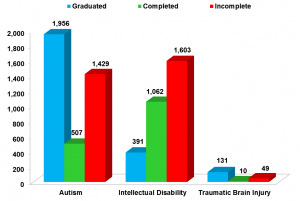
DATA SOURCE: The Data is from California Department of Education as of October 5, 2016
2013-2014
For June 30, 2014, the California Department of Education reports that 6,289 students with significant disabilities (autism, intellectual disabilities and traumatic brain injury) left K-12 education. Of those, 33% graduated, 17% received a certificate of completion, and 50% either dropped out or aged out. The table below shows more details, including the different ways a student can graduate high school with a diploma or equivalent and the ways students leave school without completion.
What this page shows us: Most students with significant disabilities are struggling to complete high school. Of those students who graduated, most had autism, and very few had an intellectual disability. Most of those with certificate of completion had an intellectual disability.
Half of students with an intellectual disability either dropped out or aged out. Finishing high school is a requirement for many entry level jobs.
| 2013 – 2014 Academic Year | Autism | Intellectual Disability | Traumatic Brain Injury | Totals |
|---|---|---|---|---|
| Grad. high school with regular diploma | 1,288 | 125 | 82 | 1,495 |
| Received high school completion (GED) | ** | ** | 0 | 11 |
| Grad. High school with diploma using exemption | 238 | 168 | 33 | 439 |
| Grad. High school with a diploma using waiver | 89 | 29 | 5 | 123 |
| Graduated Subtotal | 1,615 | 322 | 120 | 2,068 |
| Grad. high school with certificate of completion | 294 | 766 | 12 | 1,072 |
| Completed Subtotal | 294 | 766 | 12 | 1,072 |
| Reached maximum age (22) | 474 | 1,091 | 22 | 1,587 |
| Dropped out | 527 | 374 | 21 | 922 |
| Parent/self withdrawal if over 18 | 408 | 223 | 9 | 640 |
| Incomplete Subtotal | 1,409 | 1,688 | 52 | 3,149 |
| Totals | 3,318 | 2,776 | 184 | 6,289 |
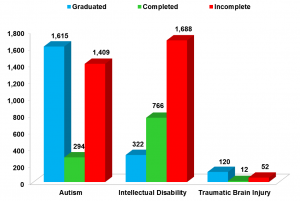
DATA SOURCE: The Data is from California Department of Education as of October 5, 2016
2012-2013
For June 30, 2013, the California Department of Education reports that 5,849 students with significant disabilities (autism, intellectual disabilities and traumatic brain injury) left K-12 education. Of those, 32% graduated, 24% received a certificate of completion, and 44% either dropped out or aged out. The table below shows more details, including the different ways a student can graduate high school with a diploma or equivalent and the ways students leave school without completion.
What this page shows us: Most students with significant disabilities are struggling to complete high school. Of those students who graduated, most had autism, and very few had an intellectual disability. Most of those with certificate of completion had an intellectual disability.
More than half of students with an intellectual disability either dropped out or aged out. Finishing high school is a requirement for many entry level jobs.
| 2012 – 2013 Academic Year | Autism | Intellectual Disability | Traumatic Brain Injury | Totals |
|---|---|---|---|---|
| Grad. high school with regular diploma | 1,126 | 203 | 69 | 1,398 |
| Received high school completion (GED) | 6 | 12 | 0 | 18 |
| Grad. High school with diploma using exemption | 188 | 133 | 21 | 342 |
| Grad. High school with a diploma using waiver | 58 | 31 | 7 | 96 |
| Graduated Subtotal | 1,378 | 379 | 97 | 1,854 |
| Grad. high school with certificate of completion | 392 | 993 | 24 | 1,409 |
| Completed Subtotal | 392 | 993 | 24 | 1,409 |
| Reached maximum age (22) | 366 | 987 | 16 | 1,369 |
| Dropped out | 294 | 300 | 24 | 618 |
| Parent/self withdrawal if over 18 | 362 | 226 | 11 | 599 |
| Incomplete Subtotal | 1,022 | 1,513 | 51 | 2,586 |
| Totals | 2,792 | 2,885 | 172 | 5,849 |

DATA SOURCE: The California Department of Education (CDE) provides special educational services to children with disabilities meeting their unique needs, in the least restrictive environment. Required by the Individuals with Disabilities Education Act (IDEA) and Elementary and Secondary Education Act (ESEA), all students must be included in the statewide assessment and accountability system. CDE developed and implement alternate performance assessment for disabled children who could not take part in the general “California Standards Tests”. CDE along with other state agencies provide help preparing disabled children and young adults’ transition from school to employment and a quality adult life. Graduating high school is essential for improving employment opportunities and lifestyles for disabled young adults.

